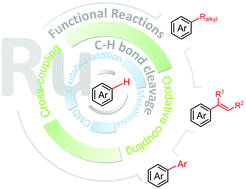Mechanistic view of Ru-catalyzed C–H bond activation and functionalization: computational advances
Abstract
Ru-Catalyzed aromatic C–H bond activation and functionalization have emerged as important topics because they have resulted in remarkable progress in organic synthesis. Both experimental and theoretical studies of their mechanisms are important for the design of new synthetic methodologies. In this review, a mechanistic view of the Ru-mediated C–H bond cleavage step is first given to reveal the C–H bond activation modes, including oxidative addition, metathesis and base-assisted deprotonation. In this process, directing groups play an important role in determining the reactivity of the C–H bond. The C–H bond activation generally leads to the formation of a Ru–C bond, which is further functionalized in the subsequent steps. The mechanisms of Ru-catalyzed arylation, alkylation, and alkenylation of arenes are summarized, and these transformations can be categorized into cross-coupling with electrophiles or oxidative coupling with nucleophiles. In addition, the mechanism of ortho-ruthenation-enabled remote C–H bond functionalization is also discussed.



 Please wait while we load your content...
Please wait while we load your content...